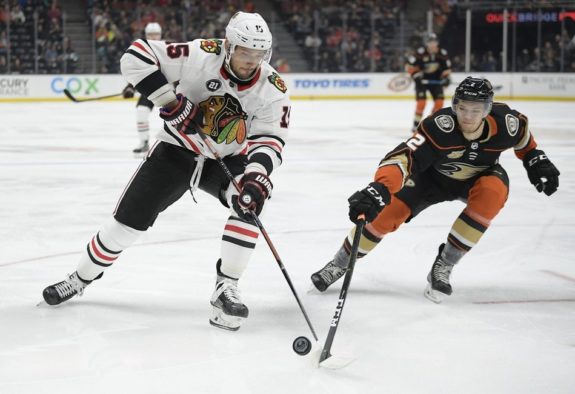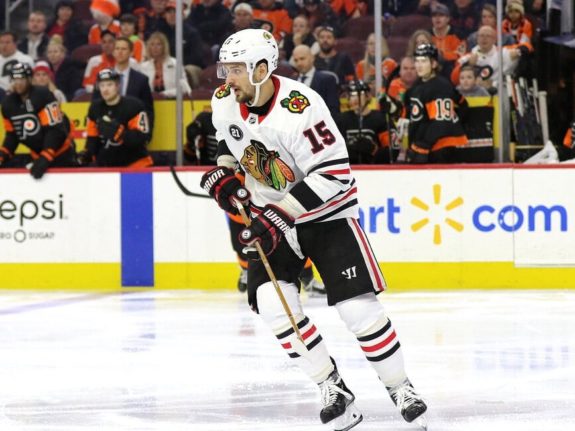On July 16, the Ottawa Senators traded veteran forward Zack Smith to the Chicago Blackhawks in return for another veteran forward, Artem Anisimov. The trade was fueled by salary cap implications for both teams, as the Blackhawks needed more cap space, and the Senators were aiming to stay above the cap floor.
Both players are 31-year-old, defensively responsible forwards, and both sported #15 for their respective clubs last season. That’s where their similarities end. While Smith brought a gritty, physical style of play to the Senators’ roster, Anisimov brings size, speed and a scoring touch.

“Artem is a big, competitive centre with excellent hands and playmaking ability. He plays a 200-foot game and will contribute to our depth on both special teams. We really like how he will fit with the makeup of our team.” – Pierre Dorion on acquisition of Artem Anisimov
From: ‘Senators acquire centre Artem Anisimov from the Chicago Blackhawks‘ – NHL
Offensive Upside
Anisimov has spent the last four years of his career playing for the Blackhawks. During that time, he has amassed three 20-goals seasons. He gets most of his scoring chances by using his speed while driving to the net. The majority of his goals come from when he finishes off a play with an in-tight deke, or a well-timed and well-placed rebound shot.
Related: Senators Give Connor Brown a Fresh Start
His overall production has seen a drop from his first two seasons with the Blackhawks. However, there is a noticeable correlation between his time on ice (TOI) and zone starts, which provides evidence towards his decreased point totals since the 2016-17 season. Nonetheless, Anisimov had 37 points last season, and has only registered fewer than 30 points in 3 of his 11 NHL seasons. Regardless of where he slots into the Senators’ lineup, he should provide some quality depth scoring.

Defensive Reliability
Reinforcing Anisimov’s offensive upside is the defensively responsible element to his game. While he isn’t going to provide the Senators with Patrice Bergeron-level shutdown capabilities, he will be able to hold his own in the defensive end. Last season he was credited with 50 takeaways and only 14 giveaways. This is a massive improvement in takeaway to giveaway ratio when compared to the 42 takeaways and 47 giveaways that Smith had for the Senators last season.
“Doesn’t matter what, I’m going to do my job out there and play hard every shift.” – Artem Anisimov
From: ‘Blackhawks’ Artem Anisimov hopes goal will reverse trend, ward off trade rumors’ – Ben Pope, Chicago Sun Times
Anisimov does struggle in the face-off dot, registering a face-off win percentage (FO%) of 45.7% last season. Smith, in comparison, registered a 49.1 FO% last season. However, the Senators have great depth at centre, so Anisimov may not have to take as many draws as he did while with the Blackhawks.
Potential in Increased Role
In the 2015-16 season, Anisimov averaged 18:05 TOI per game. In 2016-27, that dropped slightly to 17:51 TOI, but he earned a career-high 45 points. The following season is when his ice time dropped, which in turn led to a reduction in point totals. His average ice time in the 2017-18 season was 1:04 fewer than the previous season, and dropped an additional 26 seconds during the 2018-19 season. With less time on the Blackhawks’ power play, Anisimov has had to find most of his scoring at even strength.
Related: Ryan’s role in Senators’ Rebuild
Anisimov’s drop in production can also be attributed to a steep decline in his offensive zone starts. During the 2015-16 season, he started 67.1% of his shifts in the offensive zone, which dropped slightly to 65.1% in 2016-17. However, over the next two seasons his offensive zone starts dropped to 52.8% and 53.9% respectively. One could argue that the correlation between his decrease in both average TOI and offensive zone starts over the last two seasons could be why Anisimov’s offensive output has faltered.

Final Thoughts
With the previously mentioned variables in mind, a Senators resurgence is a likely possibility. Anisimov should get ample ice time, including a boost in power play and penalty kill minutes. With his size, speed and two-way capabilities, he will give the Senators a good depth option to rely on at both ends of the rink.
It’ll be interesting to see where Anisimov ends up slotting into the Senators’ lineup. Depending on what Senators coach DJ Smith decides, Anisimov could start the season with both Anthony Duclair and Connor Brown as his two wingers. All three players are fast skaters and would be more than capable of using their speed to break down defensive structures. They have the potential to create some high-flying scoring opportunities that will make the Senators exciting to watch this season.
All stats taken from hockeyreference.com